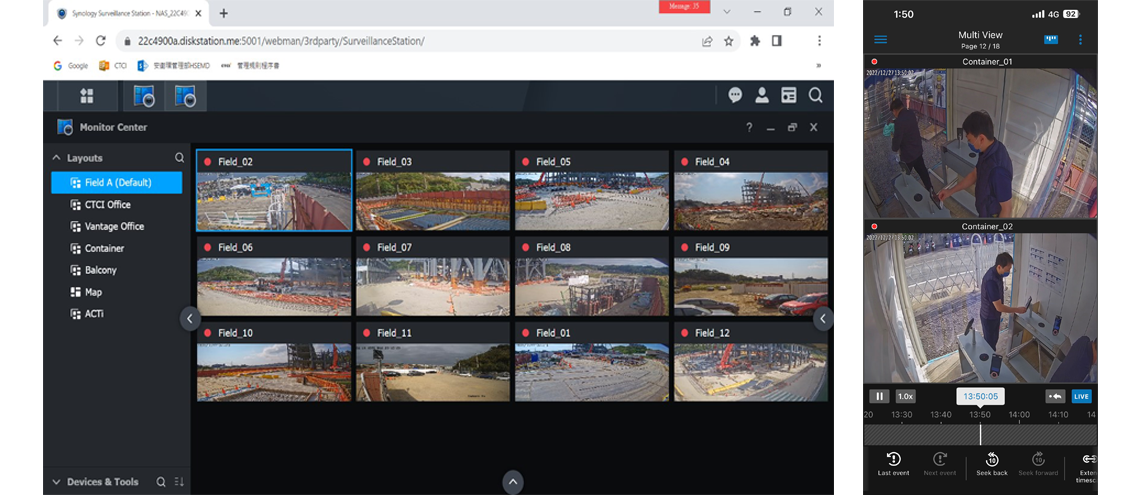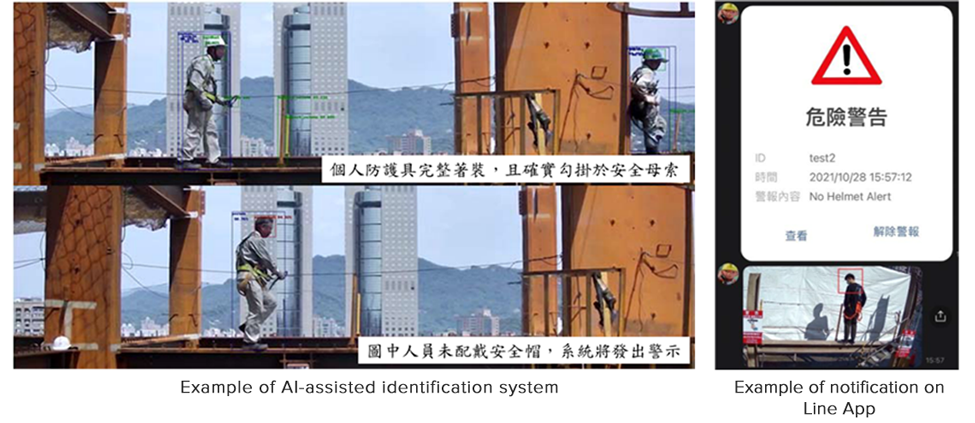Corporate Citizen
企業公民
Application of Safety and Health Technology in Construction Industry
According to Taiwan Ministry of Labor's national occupational injury statistics, falling accident accounts for the majority of construction fatality cases between 2004 and 2021. These falling accidents were not only caused by improper use of personal protective equipment (PPE), but also by unsafe openings. Moreover, negligence during crane lifting or rigging could result in serious accidents, especially when workers inadvertently enter the operation radius. It is therefore quite ineffective to solely rely on traditional occupational safety management practices and training if we want to reduce accidents. To improve occupational health and safety (OHS) management and reduce occupational accidents, CTCI keeps up with the technology trend by introducing assistive technologies, including “Site Live Video” and “AI-Assisted Identification & Notification System of PPE & Fall Protection Equipment.” These measures not only allow site management to better supervise work sites and reduce hazard risks, but also helps prevent violations or accidents in time.
Site Live Video
CTCI has set up Site Live Video to enhance safety controls for construction sites. Once CCTV cameras are set up at sites, authorized managers can monitor site footages in real-time through mobile devices or computer browsers, which enables them to control the operation status and supervise dangerous work. When unsafe practices are detected, authorized managers can notify the project sites and request immediate correction and improvement. In the case of high-risk operations, such as working at height without passage, platform, or grating, and for excavations deeper than 7 meters, additional mobile cameras are installed for monitoring and reducing the potential accident risks. Not only can the Site Live Video prevent occupational accidents, it can also be integrated with site security systems to enhance the safety and area control of construction sites. This will prevent unauthorized personnel from accessing CTCI's construction sites, offices, warehouses, and other sensitive areas. Adopting a cloud-based system, the Site Live Video automatically stores footages on remote servers. When an accident occurs, footages on the accident scenes can be retrieved to help clarify root causes and make effective improvement actions. The Site Live Video is also available for live streaming and making time-lapse recordings down to every construction detail at sites, which can be used for future analysis. The system can be accessed via multiple platforms, including Chrome, IE, and phone apps. An authorized user can control the cameras remotely, thus offering a greater level of flexibility for supervisors when monitoring the sites.

Authorized users have access to the camera via a browser or a mobile device
AI-Assisted Identification & Notification System of PPE & Fall Protection Equipment
The possibility of falling has been largely minimized in areas where protective barriers and coverings have been installed. However, there are still plenty of work areas at heights where it is impossible to set up protective barriers or covers. One example is working on steel structures. In this case, workers must put on full-body safety harnesses and be fully tied off to lifelines at work to reduce the risk of falling. To enhance the safety of working at height, CTCI has selected the Taichung Coal Handling System Project in a plan to run a field test on its “AI-Assisted Identification & Notification System of PPE & Fall Protection Equipment,” which is to monitor the proper use of PPE & & fall protection equipment by workers during steel structures operations and on platforms at height. Cameras that come with AI-assisted identification technology can significantly help prevent unsafe actions that may lead to accidents in such a high-risk environment. If the workers are not fully tied off to lifelines, or are not wearing PPEs, such unsafe practices will automatically be flagged by the system. Pictures of violation will be taken, and the management will receive alert notices via mobile devices, so that they can immediately intervene and stop such unsafe practices to prevent falling accidents.

Conclusion
Nowadays, businesses worldwide are actively seeking strategies related to intelligent transformation. It is worthwhile for businesses to think about the ways that emerging technologies can provide management assistance to the construction industry. One area that can benefit from such technologies is “safety,” which is of paramount importance at construction sites. To enhance OHS management performance and prevent accidents at large-scale construction sites with complex interfaces, CTCI has introduced intelligent OHS management tools for high-risk operations such as working at heights and lifting operations. Such tools can help our safety personnel inspect the safety status of construction sites at any time, find out if there are potential risks and hazards, and fulfill our job as a safety keeper. As a company with a vision to become “the most reliable global engineering services provider,” CTCI actively seeks hi-tech applications on occupational safety and health management. Hopefully, as AI technology matures, there will be more successful cases to come and more statistical data to be collected by CTCI. By continuing to integrate innovative methods to enhance occupational safety and health performance, CTCI is heading towards the goal of “ZERO INCIDENT.”


